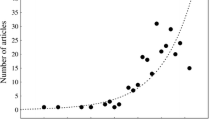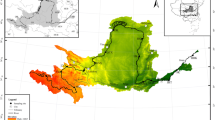Abstract
The opening of the Suez Canal in 1869 caused a migration generally from the Red Sea to the Mediterranean, rarely the opposite direction, and 63 lessepsian fish species penetrated into the Mediterranean by way of this canal. These species usually spread northward and most of them can establish wide populations in this area, but some of them can not be successful with respect to establishment. Thus, it is clearly seen that there are a lot of factors influencing the success of species with respect to migration, spreading and establishment. So, the lessepsian migration has been formed by the effects of these factors. Lessepsian species also have the ability to adapt to the ecological conditions of their new environment. Therefore, the influential factors, their effectiveness and the observed changes in lessepsian species due to the effects of these factors have been discussed by considering fishes in this paper.


Similar content being viewed by others
Abbreviations
- CIESM:
-
International Commission for the Scientific Exploration of the Mediterranean Sea
- EEA:
-
European Environment Agency
- TUDAV:
-
Turkish Marine Research Foundation
References
Ak Y (2004) Mersin Ili Erdemli Aciklarinda Yasayan Bazi Teleost Baliklarin Pelajik Yumurta ve Larvalarinin Dagilimi ve Bollugu. Ege Universitesi Fen Bilimleri Enstitusu Doktora Tezi. Bornova-Izmir. 387p. (in Turkish)
Akyol O, Unal V, Ceyhan T, Bilecenoglu M et al (2005) First record of the silverside (Gmelin, 1789), in the Mediterranean Sea. J Fish Biol 66:1183–118
Andaloro F, Azzurro E (2004) The Sicily channel, a crossroad between Atlantic and Indo-Pacific Worlds. 13th international conference of aquatic invasive species. http://www.icais.org/pdf/21Tuesday/B/tues_b_l_am/Franco_Andaloro.pdf. Cited 25.04.2006
Avsar D (1999) Physico-chemical characteristics of the Eastern Mediterranean in relation to distribution of the new Scyphomedusae (Rhopilema nomadica). Turk J Zool 23(2):605–616 (in Turkish)
Bariche M, Saad M (2005) Settlement of lessepsian blue barred parrotfish Scarus ghobban (Teleostei-Scaridae) in the Eastern Mediterranean. JMBA2—biodiversity records. Online published. http://www.mba.ac.uk/jmba/pdf/5049.pdf. Cited 20.11.2006
Basusta N, Basusta AG, Koc HT et al (2002) Distribution of lessepsian fishes in the Turkish Mediterranean coasts. Workshop on lessepsian migration. 20–21 July 2002. Gokceada-Turkey, pp 100–106
Basusta N, Erdem U (1998) Iskenderun Korfezi Baliklari Uzerine Bir Arastirma. Turk J Zool 24:1–19 (in Turkish)
Ben-Tuvia A (1966). Red sea fishes recently found in the Mediterranean. Copeia 2:254–275
Ben-Tuvia A (1973) Man made changes in the Eastern Mediterranean Sea and their effect on the fishery resources. Mar Biol 19:197–203
Ben-Tuvia A (1977) Immigration of fishes through the Suez Canal. Fish Bull 76:249–255
Ben-Tuvia A (1985) The impact of the lessepsian (Suez Canal) fish migration on the Eastern Mediterranean ecosystem. In: Moraitou-Apostolopoulo M, Kiortsis V, (eds) Mediterranean marine ecosystem, Plenum Pres, New York, 367–375
Ben-Yami M, Glaser T (1973) The invasion of Saurida undosquamis (Richardson) into the Levant Basin—an example of biological effect of interoceanic canals. Fish Bull 72(2):359–373
Castriota L, Andaloro F (2005) First record of lessepsian fish Siganus luridus in the Tyrrhenian Sea. JMBA2—biodiversity records. Online published. http://www.mba.ac.uk/jmba/pdf/5122.pdf. Cited 21.11.2006
CIESM (2006) Atlas of exotic fishes in the Mediterranean. http://www.ciesm.org/atlas/appendix1.html, Cited 08.12.2006
Cirik S, Akcali B (2002) Denizel Ortama Yabanci Turlerin Tasinip Yerlesmesi: Biyolojik Isgalin Kontrolu, Hukuksal, Ekolojik ve Ekonomik Yonleri. Ege University Journal of Fisheries and Aquatic Sciences 19(3–4):507–527 (in Turkish)
Corsini M, Margies P, Kondilatos G, Economidis PS et al (2005) Lessepsian migration of fishes to the Aegan Sea: first record of Tylersius spinosissimus (Tetradontidae) from the Mediterranean, and six more fish records from Rhodes. Cybium 2005 29(4):347–354
Corsini M, Margies P, Kondilatos G, Economidis PS et al (2006) Three new exotic fish records from the SE Aegean Sea greek waters. Sci Mar 70(2):319–323, ISSN: 0214–8358
Doumenge F (1996) The Mediterranean crises. Global Environment Information Centre (GEIC) 14 November 1996, Tokyo, Japan. http://www.unu.edu/unupress/lecture16–17.html. Cited 15.04.2006
Dulcic J, Pallaoro A (2003) Lessepsian fish migrants reported in the Eastern Adriatic Sea: an annotated list. Annales Ser Hist Nat UDK 597.5:591.9(262.3-12), pp 137–144
EEA (1999) State and pressures of the marine and coastal Mediterranean environment. Copenhagen, ISBN: 92-9167-187-8. 44
Fısh Base (2006) Fish data base. http://www.fishbase.org/. Cited 20.10.2006
Galıl BS, Zenetos A (2002) A sea change. Exotics in the Eastern Mediterranean. In: Leppäkoski E, Gollasch S, Olenin S (eds) Invasive aquatic species of Europe: distribution, ımpacts, and management. Kluwer Academic Publishers, Dordrecht, pp 325–336
Golani D (1990) Environmentally-induced meristic changes in lessepsian fish migrants, a comparison of source and colonizing populations. Bulletin de I’Institut Oceanographique, Monaco. Special 7
Golani D (1993) Tropic adaptation of Red Sea fishes to the Eastern Mediterranean environment—review and new data. Isr J Zool 39:391–402
Golani D (1996) The marine ichthyofauna of the Eastern Levant—history, inventory, and characterization. Isr J Zool 42:15–55
Golani D (1998) Impact of Red Sea fish migrants trough the Suez Canal on the aquatic environment of the Eastern Mediterranean. Yale F and S Bulletin, pp 375–387
Golani D (1999) The gulf of Suez ichthyofauna—assemblage pool for lessepsian migration into the Mediterranean. Isr J Zool 45:79–90
Golani D, Ben-Tuvia A (1989) Characterization of lessepsian (Suez Canal) fish migrants. In: Spanier E, Steinberger Y, Luria M (eds) Environmental quality and ecosystem stability, vol 4-B. ISEEQS, Jerusalem, Israel, pp 235–243
Golani D, Diamant A (1991) Biology of the Sweeper, Pempheris vanicolensis Cuvier and valenciennes, a lessepsian migrant in the Eastern Mediterranean, with a comparison with the original Red Sea population. J Fish Biol 38:819–827
Gokoglu M, Bodur T, Kaya Y et al (2003) First record of the Red Sea bannerfish (Heniochus intermedius Steindachner, 1893) from the Mediterranean Sea. Isr J Zool 49(4):324–325
Gucu AC, Bıngel F (1994) Trawlable species assemblages on the continental shelf of the Northeastern Levant Sea (Mediterranen) with an emphasis on lessepsian migration. Acta Adriat 35(1/2):83–100, ISSN: 0001-5113
Kıdeys AE (1996) Akdeniz Kiyilarinda Zehirli Bir Deniz Anasi: Rhopilema nomadica Sualti Dunyasi, Aylik Doga Dergisi. Yil : 1, Sayi 5. 83p. (in Turkish)
Madl P (1999) Essay about the phenomenon of lessepsian migration. Colloquial meeting of marine biology I. Salzburg, 1999. http://www.sbg.ac.at/ipk/avstudio/pierofun/lm/lesseps.htm. Cited 22.03.2006
Mater S, Togulga M, Kaya M et al (1995) Lesepsiyen Balik Turlerinin Turkiye Denizlerinde Dagilimi ve Ekonomik Onemi. II. Ulusal Ekoloji ve Cevre Kongresi Bildirileri. 11–13 Eylul, Ankara. 453–432p. (in Turkish)
Olden JD, Poff NL, Bestgen KR et al (2006) Life-history strategies predict fish invasions and extirpations in the Colorado River Basin. Ecol Monogr 76(1):25–40
Por FD (1973) The nature of lessepsian migration through the Suez Canal. Rapp Comm Int Mer Medit 21:679–682
Por FD (1978) The influx of Red Sea biota into the Mediterranean by way of the Suez Canal, vol 23. Spinger, Berlin, 228 pp
Taskavak E, Mater S, Bilecenoglu M et al (1998) Kizildeniz Gocmeni Baliklarin Dogu Akdeniz Kiyilarimizdaki (Mersin-Samandag) Dagilimi ve Bolge Balikciligina Etkileri. III. Su Urunleri Sempozyumu. 10–12 Haziran 1998. Erzurum/Turkiye. 151–162p. (in Turkish)
Tortonese E (1964) The main biogeographical features and problems of the Mediterranean fish fauna. COPEIA 1:98–107
TUDAV (2006) Kuresel Isinma ve Turkiye Denizleri Raporu. Turk Deniz Arastirmalari Vakfi. http://www.tudav.org/kuresel_isinma.htm. Cited 25.04.2006 (in Turkish)
Wiens JJ, Graham CH (2005) Niche conservatism : integrating evolution, ecology and conservation biology. Annu Rev Ecol Syst 36:19–39
Yilmaz AB, Basusta N, Ismen A et al (2002) Iskenderun Korfezi’nin Guneydogu Kiyilarinda Materyal Birikimi Uzerine Bir Calisma. E.U. J Fish Aquat Sci 19(3–4):485–488 (in Turkish)
Author information
Authors and Affiliations
Corresponding author
Rights and permissions
About this article
Cite this article
Mavruk, S., Avsar, D. Non-native fishes in the Mediterranean from the Red Sea, by way of the Suez Canal. Rev Fish Biol Fisheries 18, 251–262 (2008). https://doi.org/10.1007/s11160-007-9073-7
Received:
Accepted:
Published:
Issue Date:
DOI: https://doi.org/10.1007/s11160-007-9073-7




